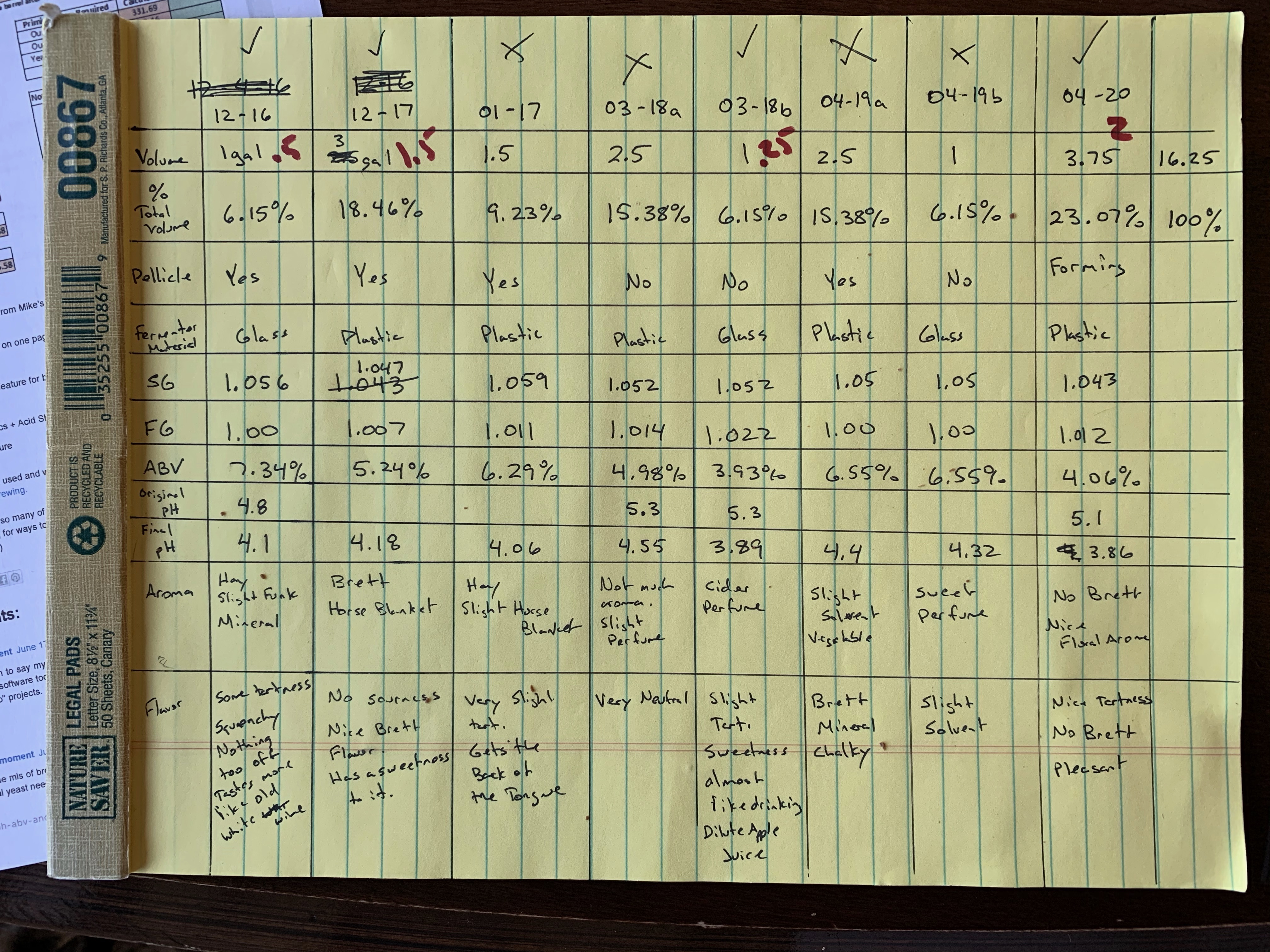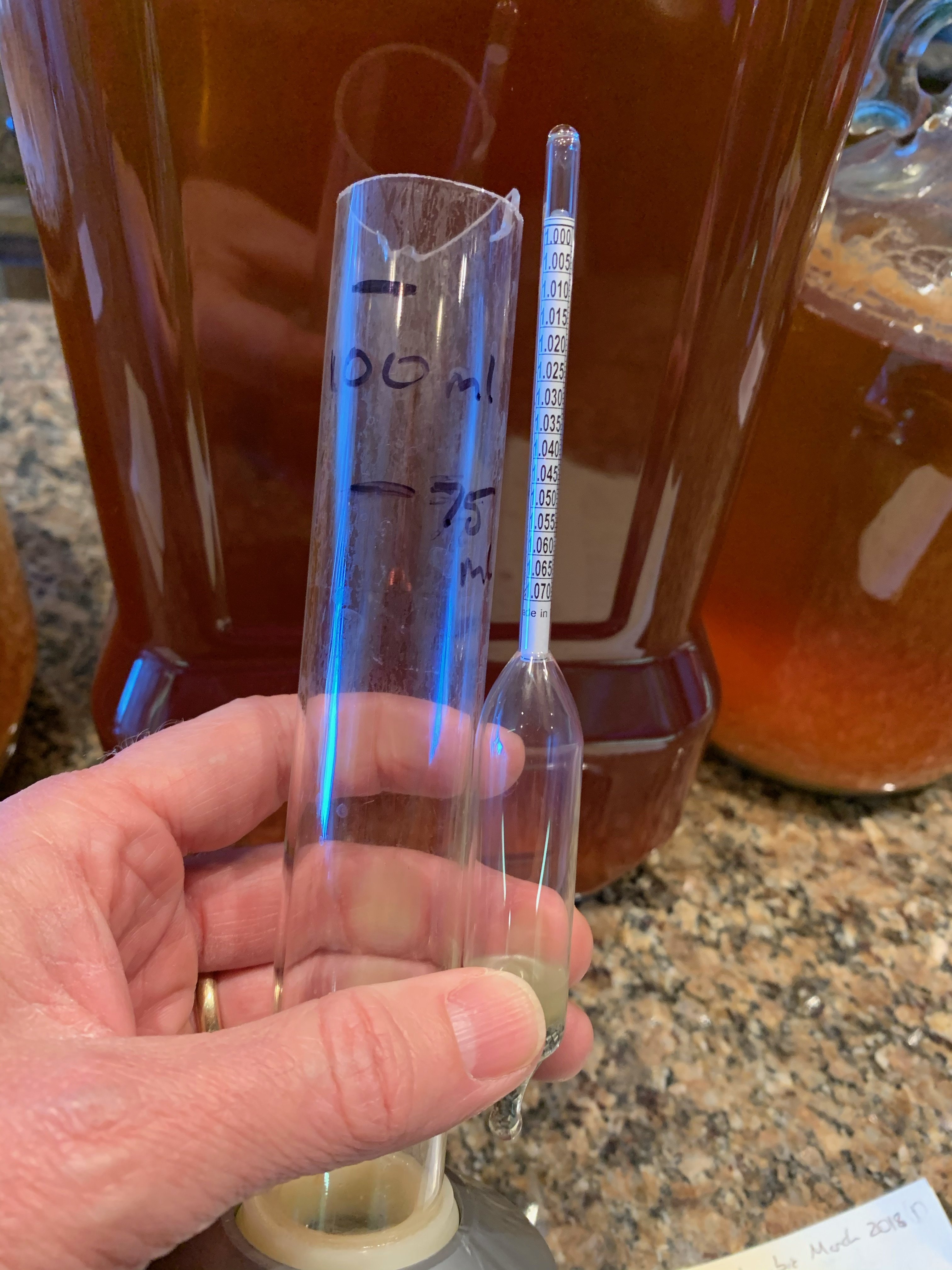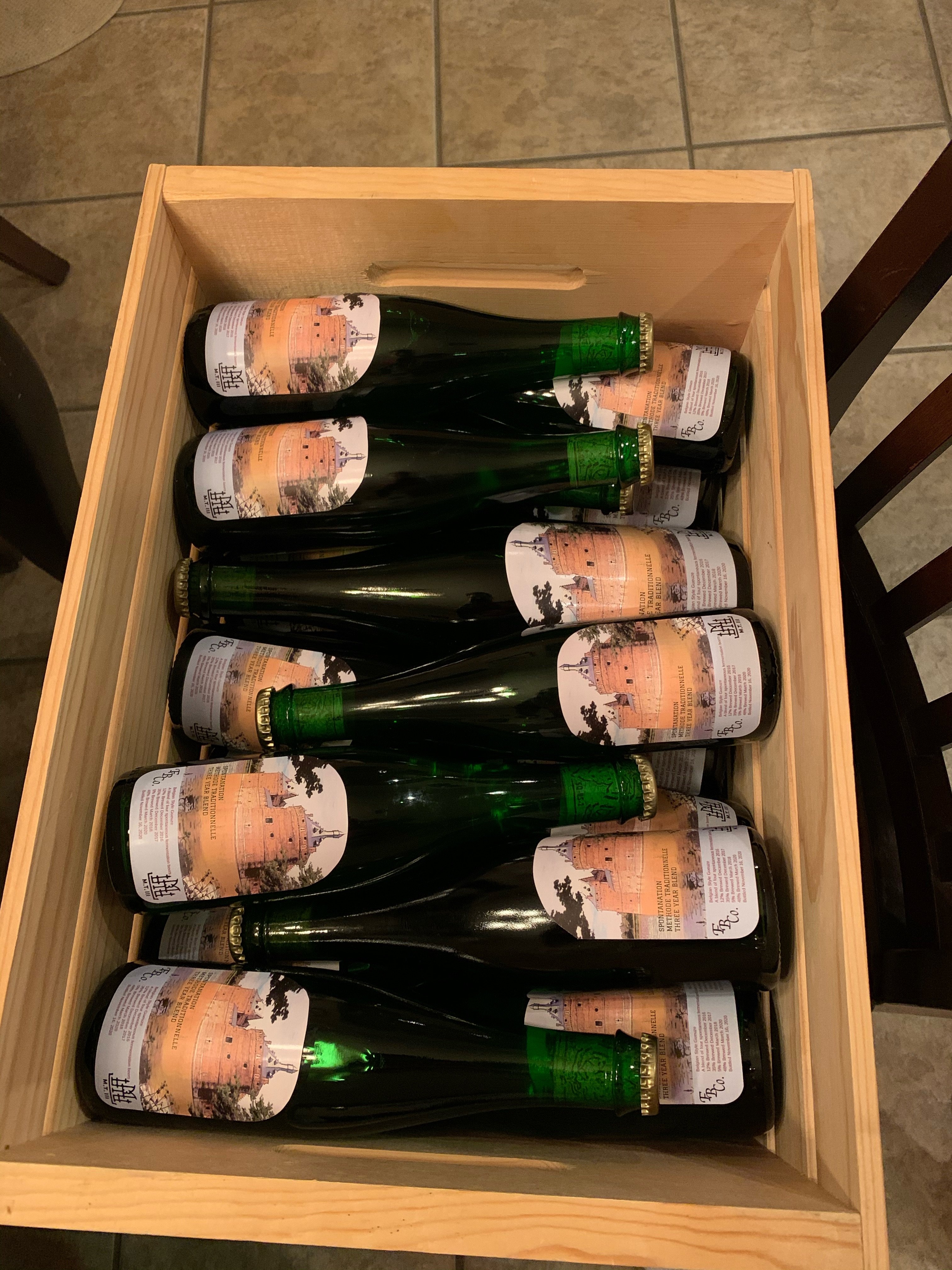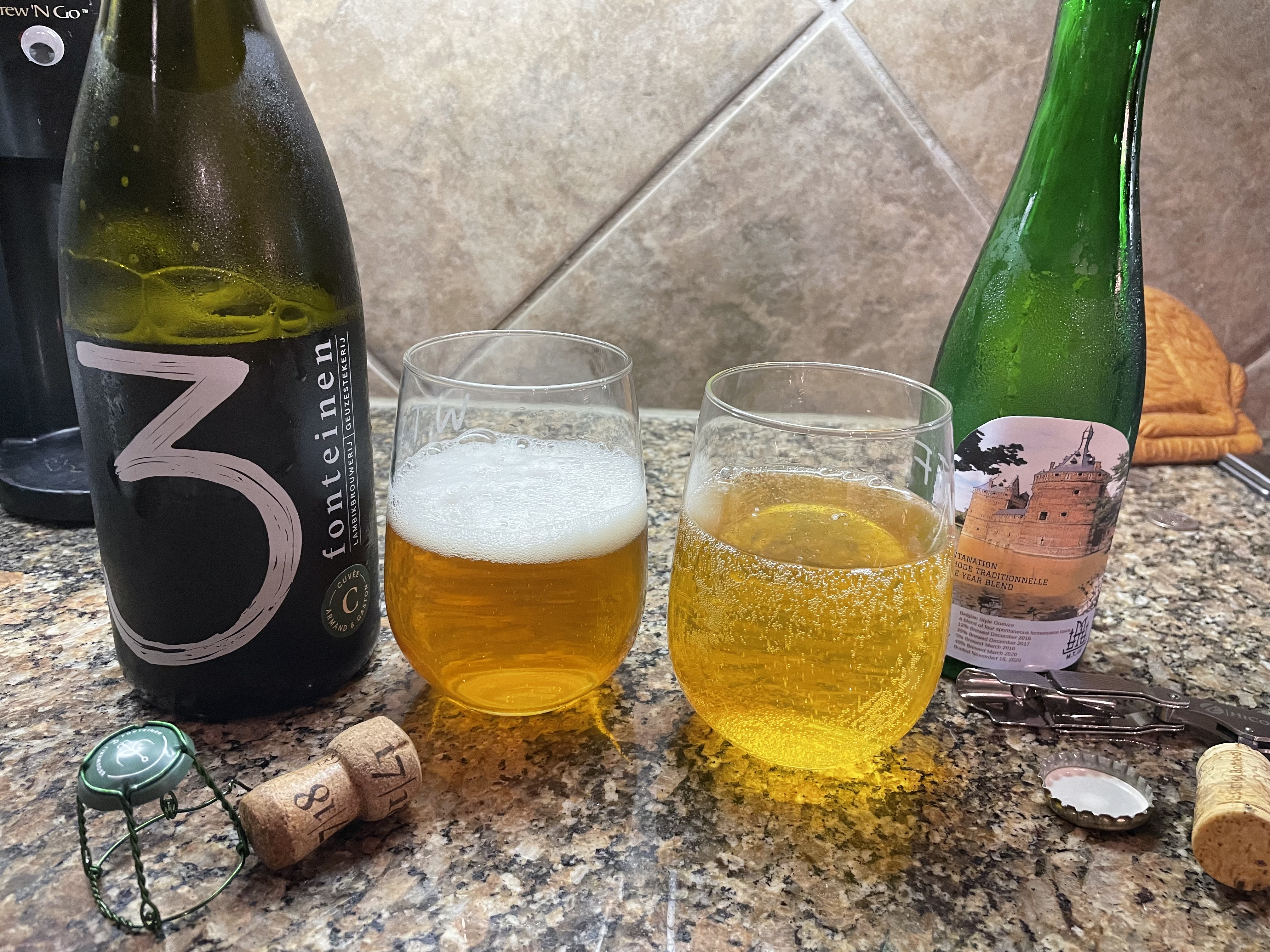December 2016 I started brewing traditional Lambic Recipes and putting the wort in disposable aluminum pans on my table in the back yard to capture yeast and bacteria over night. I would brew one or two batches in the winter and spring. Mostly, these beers were ignored. I had them sitting in various closets throughout the house. This weekend, I figured it was time to pull them all out, do a tasting, gravity and pH reading for each one and come up with a blend.
I created a table to list Volume, Pellicle Present, Fermenter Type Glass or Plastic, SG, FG, ABV, Starting pH, Current pH and then Aroma and Tasting Notes. I figured the table would help me come up with any correlation to Brett, Lactic etc. but It seems to be random. I've been using aged hops and varied the amount of hops to see if that affected Lactic Acid production. My youngest beer is really the only beer that I would say has any real acidity and I used 0.5 oz of hops for a 4.5 gallon batch boiled for 3 hours. This beer I also used a 6 gallon SS pot instead of Aluminum pans. I figured the SS pot would hold temperature longer which may benefit Lactic.
I used the Blending Calculator found here Blending Calculator - pH, ABV and Carbonation
I used my notes as a guide but I also treated the 8 samples like a mini BOS competition and quickly eliminated ones that I did not like and then narrowed it down. I determined that 4 were usable. I was not wowed with the blend but it had nice tartness and some brett funk. I figure, I need to follow through with the project to learn and hopefully produce something drinkable. The big unknown was the youngest beer still had a lot of residual sugar so based on the calculator I did not add any priming sugar or additional yeast. My plan was to let the bottles condition a minimum of 4 months anyway. I did fill one plastic bottle so I can give it the squeeze test to see if carbonation is happening. The red sharpie marker is the volume of the samples I used. I used a scale to measure the blend going into the bottling bucket.
My total volume of the blend was 4.25 gallons. I got 6 - 750ml Bottles, 12 375ml Vinny Bottles, 12 375ml Gueuze Bottles and 6 500ml Heavy Bottles. All of the bottles should be able to handle high carbonation if that happens. If the blend if worth entering into competitions I can enter the Vinny Bottles.
I racked the excess beer from the youngest beer into a smaller container as I'm hoping it will continue to develop and be part of the next blend. My plan for the future will be to brew one lightly hopped beer and one moderately hopped beer each winter, spring so hopefully, I have a nice blend of Brett and Lactic.
Tools that I used that were very helpful and will make sampling and testing beers easier in the future.
1. Volume Pipette Pump. Makes it easy to pull 25ml sample. https://smile.amazon.com/gp/product/B00191HNKY/ref=ppx_yo_dt_b_search_asin_title?ie=UTF8&psc=1
2. Pipettes - Already Sterile so just open the package and pull the sample https://smile.amazon.com/gp/product/B01E16K7FG/ref=ppx_yo_dt_b_search_asin_title?ie=UTF8&psc=1
3. Short Hydrometer - Only need 75ml sample and total displacement is 100ml so I cut a plastic hydrometer tube shorter to make inserting the hydrometer easier https://smile.amazon.com/gp/product/B014EZOLJC/ref=ppx_yo_dt_b_search_asin_title?ie=UTF8&psc=1




I created a table to list Volume, Pellicle Present, Fermenter Type Glass or Plastic, SG, FG, ABV, Starting pH, Current pH and then Aroma and Tasting Notes. I figured the table would help me come up with any correlation to Brett, Lactic etc. but It seems to be random. I've been using aged hops and varied the amount of hops to see if that affected Lactic Acid production. My youngest beer is really the only beer that I would say has any real acidity and I used 0.5 oz of hops for a 4.5 gallon batch boiled for 3 hours. This beer I also used a 6 gallon SS pot instead of Aluminum pans. I figured the SS pot would hold temperature longer which may benefit Lactic.
I used the Blending Calculator found here Blending Calculator - pH, ABV and Carbonation
I used my notes as a guide but I also treated the 8 samples like a mini BOS competition and quickly eliminated ones that I did not like and then narrowed it down. I determined that 4 were usable. I was not wowed with the blend but it had nice tartness and some brett funk. I figure, I need to follow through with the project to learn and hopefully produce something drinkable. The big unknown was the youngest beer still had a lot of residual sugar so based on the calculator I did not add any priming sugar or additional yeast. My plan was to let the bottles condition a minimum of 4 months anyway. I did fill one plastic bottle so I can give it the squeeze test to see if carbonation is happening. The red sharpie marker is the volume of the samples I used. I used a scale to measure the blend going into the bottling bucket.
My total volume of the blend was 4.25 gallons. I got 6 - 750ml Bottles, 12 375ml Vinny Bottles, 12 375ml Gueuze Bottles and 6 500ml Heavy Bottles. All of the bottles should be able to handle high carbonation if that happens. If the blend if worth entering into competitions I can enter the Vinny Bottles.
I racked the excess beer from the youngest beer into a smaller container as I'm hoping it will continue to develop and be part of the next blend. My plan for the future will be to brew one lightly hopped beer and one moderately hopped beer each winter, spring so hopefully, I have a nice blend of Brett and Lactic.
Tools that I used that were very helpful and will make sampling and testing beers easier in the future.
1. Volume Pipette Pump. Makes it easy to pull 25ml sample. https://smile.amazon.com/gp/product/B00191HNKY/ref=ppx_yo_dt_b_search_asin_title?ie=UTF8&psc=1
2. Pipettes - Already Sterile so just open the package and pull the sample https://smile.amazon.com/gp/product/B01E16K7FG/ref=ppx_yo_dt_b_search_asin_title?ie=UTF8&psc=1
3. Short Hydrometer - Only need 75ml sample and total displacement is 100ml so I cut a plastic hydrometer tube shorter to make inserting the hydrometer easier https://smile.amazon.com/gp/product/B014EZOLJC/ref=ppx_yo_dt_b_search_asin_title?ie=UTF8&psc=1


























![Craft A Brew - Safale BE-256 Yeast - Fermentis - Belgian Ale Dry Yeast - For Belgian & Strong Ales - Ingredients for Home Brewing - Beer Making Supplies - [3 Pack]](https://m.media-amazon.com/images/I/51bcKEwQmWL._SL500_.jpg)




































